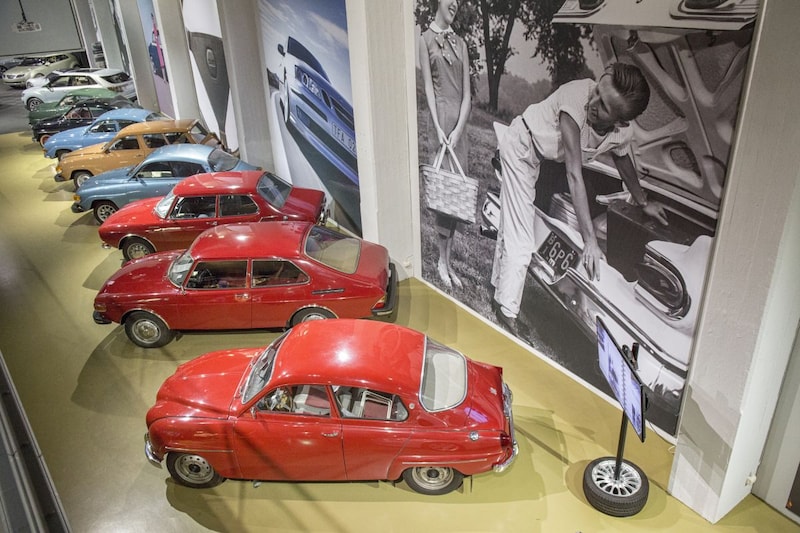Highlights Saab Car Museum

The brand may officially no longer exist, but Saab’s heritage is lovingly cherished in an old depot in the former home of Trollhättan. Since we were in the area, we took a look.
Anyone who has followed the car news a little bit over the past decade knows the story behind the tragic demise of Saab. After the customer first failed because the cars were no longer stubborn enough after the takeover of Saab by General Motors, the American concern itself also threw in the towel in 2009. What followed was a lot of ambiguity and legal tug-of-war, with our own Victor Muller in 2010 still posing as the savior with Spyker. When this resuscitation attempt also failed, Saab was officially bankrupt and the wreckage was taken over by a Swedish-Chinese investment group called NEVS (National Electric Vehicle Sweden). Somewhat hopeful messages still appear every now and then, but Saab ‘as we knew it’ will never come back. Fortunately, Saab’s rich history has not been thrown into the open. In the Swedish town of Trollhättan, just above Gothenburg, you will find a simply furnished, but no less interesting museum. We’ll take you through the highlights.

In 1945 Saab decided to expand its aircraft branch with cars. The first production model was this 92 from 1950, a very streamlined model for that time – here is the link with the aircraft. The drive is provided by a 25 hp, longitudinally placed two-cylinder two-stroke engine of 764 cc. It drives the front wheels via a three-speed manual gearbox. You can clearly recognize the teardrop shape of the ‘Exp vagn 001’ or 92001 from 1947, the ‘primal Saab’ prototype with DKW engine that modeled for the 92. Four prototypes were built before the production 92 saw the light of day.


Saab may not be the first brand you think of when you think of racing, but in 1960 Saab engineers took their shot at the Formula Junior championship. Stubborn as they were, they not only opted for a space frame instead of the usual tubular chassis, but also for front-wheel drive. The 940 cc three-cylinder (86 hp) was therefore in the front, which resulted in a weight distribution of 70/30 between the front and rear axle. Not ideal, and the car – in which Saab legend Erik Carlsson drove, among others – was therefore enormously understeered. Only two cars were built.

Not all Saabs have numbers as type designation. The Sonett, for example, of which you have two different closed versions and one open, the Super Sport. The latter, also known as Sonett I or 94 (so a number after all!) has a plastic body, only six were built between 1955 and 1957 because series production never happened. This white one is the very first. 258 of the Sonett II, also made of plastic, were built from 1966 with a three-cylinder two-stroke engine before switching to Ford’s V4. From 1970, that engine also ended up in the more modern Sonett III with folding headlights, which was mainly aimed at the American market.

Below you can see the evolution of the 92 (1950) to the 96, which remained in production until 1980. There was also a station wagon: the 95. In total, just over 730,000 units of the 92, 93, 95 and 96 were built.

Saab was a pioneer in the turbo field, with the engineer Per Gillbrand (‘Mr. Turbo’), who died in 2016, being seen as a demigod in Trollhättan. The 99 was the first Saab with a turbo engine in 1978. Its 2.0-liter four-cylinder delivered 145 hp thanks to the extra supercharging, which made it seriously fast for the time. A nice detail are the light metal ‘Inca’ wheels, a graphic representation of turbine blades. For more 99 Turbo you have to look here, because we received a copy of the museum collection when we visited the museum.

Saab icon Erik Carlsson, who died in 2015, won the Monte Carlo rally with this 96 in 1962 and 1963.

In 1985, Saab built this EV-1 concept car, which – contrary to what the name suggests – does not have an electric powertrain. It is actually a 900 Turbo 16V with a different body. The engine has been boosted to 290 hp and gives it a top speed of 270 km/h. The car has a very small role in the film Back to the Future 2. There are solar cells in the roof, which provide the electricity for cooling the interior. A detail that would later return in production Saabs is the switchable lighting of the instruments (‘Night panel’), whereby only the relevant part of the speedometer remains visible.

At Saab they were always up for a little experiment, like this ‘Monster’ from 1959 with its two three-cylinder two-stroke engines mounted transversely in the front. Together good for 140 hp and a top speed of 196 km / h. The regulations stipulated that this type of construction is not allowed, so this monster has never been raced in competition.

Choice of 120 cars
The Saab Car Museum in Trollhättan has about 120 cars in its collection, of which about 70 are on display in the museum. Changing themed exhibitions are held regularly. During our visit these were ‘Form follows function’ with a number of concept cars and an overview of the 100,000 kilometer endurance testing that Saab did with the 9000 Turbo at the Talladega Superspeedway in Alabama in the US. For more information about the exhibitions, opening hours and prices, visit saabcarmuseum.se.

– Thanks for information from Autoweek.nl